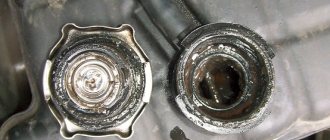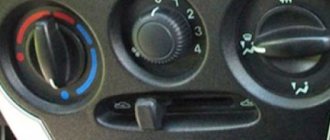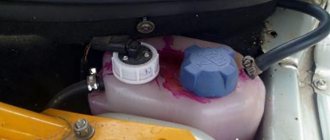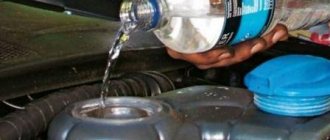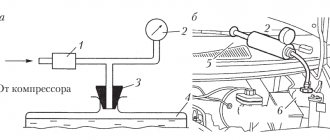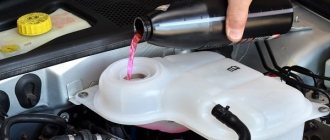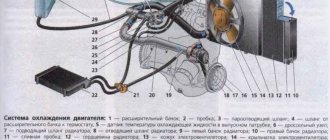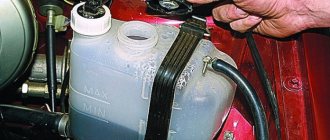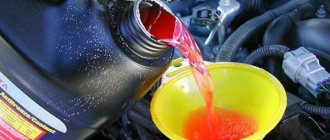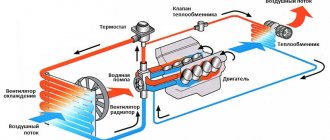Air lock in the cooling system, what to do!?
A problem as simple as an air lock in the cooling system can cause serious damage to the engine if it is not addressed promptly.
The presence of air in the cooling system almost completely reduces the cooling efficiency, and the engine can easily overheat. And, as you know, engine overheating, in most cases, threatens major repairs. It's better to spend time finding and solving this problem. An air lock in the cooling system can go away on its own; under pressure, air will pass through the system and exit into the expansion tank.
But hoping for such a solution to the problem is very risky. Not on all car models, the expansion tank is located at the very top of the cooling system, so air may not escape into it, and the air lock will remain.
How does air enter the cooling system?
Most often, the engine cooling system (ECS) becomes airy due to two main reasons. There are, of course, other reasons, but 95% of all cases fall under these two reasons. The first is replacing the coolant. When filling, you may not notice or notice that 100-300 grams less antifreeze has entered the system, this indicates that there is definitely a blockage of air.
The second reason is a repair that involved interference with the cooling system. If, after repairs involving intervention in the ODS or replacement of antifreeze, the engine temperature goes beyond normal limits, then, first of all, you need to remove air from the system, and only then continue driving. The system may also become airy due to a breakdown of the cylinder head gasket. If this gasket is damaged, gases from the combustion chamber can break into the cooling channels and enter the coolant. With such damage to the cylinder head gasket, the engine may run stably, but other symptoms of a broken gasket will soon appear. The engine temperature, in this case, may not be critical, but will be increased.
Symptoms of an air lock in the cooling system
The main symptom of the presence of air in the ODS is increased engine temperature. If you do not turn off the engine in time when the temperature rises, overheating is inevitable. Overheating occurs due to the fact that the circulation of coolant is disrupted; it may not enter the radiator.
The second symptom is that no warm air comes out of the stove. Due to the lack of normal circulation, antifreeze does not enter the stove radiator and, accordingly, does not heat it. If this symptom is present, everything else may be normal. The air lock can only be located in the heater radiator, and not affect the cooling as a whole.
Coolant leaks can also be a symptom of an airy ODS. If antifreeze leaks out, it means that the cooling system is not sealed and air can get into it. It doesn’t matter where the leaks are found, it could be the radiator, the cylinder block or the pipes, all of these elements can equally cause an air lock to appear.
The main symptom of a broken cylinder head gasket is the presence of small bubbles in the expansion tank. If such bubbles are found, then there is no point in expelling the air plug; the gasket needs to be replaced or other repairs are needed. You can get to the repair site on your own, and you need to do this as soon as possible.
Deaeration of a centralized system
In apartment buildings and the private sector, central heating is designed with air collectors. They are located at the top point. When the heating system is aired, just open the tap. When an air lock forms, opening the air collector allows air to rise through the pipes. Thus, the entire system is filled with water, and there are no plugs left.
In apartments, to ventilate the system you just need to open the tap
In an apartment or house, you can remove the blockage by bleeding the air in the place where it formed. For this purpose, batteries are equipped with taps. It must be borne in mind that it is unacceptable to install plumbing elements. Special valves called air vents are used . If the owner of the premises installs a water tap instead of an air vent and accidentally drains a certain amount of coolant from the system, he will have to pay a fine.
The vent is opened using a special key or a regular screwdriver. Extreme care must be taken, but even if everything is done correctly, it is possible that not only air will come out of the radiator, but water will also leak out.
Guys, please give me some advice. Maybe someone has encountered this. The problem is this: I changed the antifreeze and after the replacement the heater started to air (the inlet pipe is hot and the exhaust pipe is cold), the engine maintains normal temperature. Camry car, 4S-FE engine. How to remove air from the stove now? It's -20 outside and it's cool to drive without a heater)) Thank you in advance for your advice.
Start the engine without closing the radiator cap, raise the speed to 1200-1400, gradually add antifreeze until the bubbles stop. In general, when driving, a working pump should push through on its own.
As an option: drive the front up a steep hill and hold the speed at 2-3 thousand until the heater return hose warms up. The fact is that in many cars the stove is located above the level of the radiator and air accumulates in it. I myself had such a trick. Good luck!
CORSA, how quickly did your stove collapse on the hill? Did you open the radiator cap or not? Today I stood on the hill with my face up for about 20 minutes and revved up the gas. It didn’t help (((Maybe not enough time has passed. At a service station like under vacuum, using some kind of machine, they change the antifreeze, but they charge 500 rubles for the work.
Is it like under vacuum, in airless space or something? The service station won't tell you that yet. Another option: park the car with its face up, remove the heater return hose, start adding antifreeze until it comes out of the return line. Then the hose is put in place, and start. RPM 1500 minutes 2-3, turn off, check the level, top up, start again, etc. until warm air comes out of the stove. Good luck. By the way, is the air coming out of the stove completely cold or not warm enough?
How to bleed the system?
The easiest way to get rid of air is to expel it through a heated throttle body or carburetor. On almost all cars, the throttle assembly is the highest point of the SOD, so air must be expelled from this place. Before starting the procedure, you need to fully open the heater tap. The tap must be open for each method of removing an air lock. You should disconnect one of the throttle (or carburetor) heating hoses, unscrew the cap of the expansion tank and, pressing your lips tightly, blow into the tank. When antifreeze flows from the pipe, this pipe must be put in place. This means that air has been removed from the system.
The second way is to disconnect one of the same pipes with the engine running and wait until the antifreeze flows. The disadvantage of this method is that it is dangerous. You can burn your fingers with hot coolant, and in the hustle and bustle you may not have time to quickly put the pipe back on.
The essence of the third method is to raise the front of the car and allow the air to escape through the expansion tank. You can raise the front part using jacks or simply by driving up a hill. When the front part is raised, you need to unscrew the expansion tank cap and start the engine. The air lock in the cooling system will go up to the expansion tank and exit through it. To improve the circulation of coolant, it is recommended to rev it up a little, in the range of 1500-2000 rpm. As air escapes, antifreeze will go into the system, so you need to monitor its level and top up if necessary.
General recommendations and tips for preventing system airing and engine overheating
- Always ( ALWAYS, and this is very important) monitor the coolant level in the radiator neck or expansion tank and, if necessary, add distilled water if you have a modern car with antifreeze class 11G and higher. By the way, monitoring the coolant level (as well as the oil level in the engine crankcase, as well as the pressure in the wheels) is prescribed by the recommendations for the so-called EO - daily car maintenance, prescribed in your Instructions.
- Systematically, and especially before the autumn-winter period of operation, check the density of antifreeze in your system.
- Always be careful and monitor instrument readings.
This is the result of that same water hammer. Need comments?
Even at the slightest suspicion of an increase in temperature, it is better to stop immediately and try to find out the reason. If the indicator arrow systematically or periodically attempts to leave its usual nominal values, immediately contact a car service center.
If you need specialized specialists, then use the recommendations and tools of the Autobooking website and independently find the service station you need in your city or region.
If you need to replace antifreeze, use the form below to find a service station:
Sergey Zhebalenko, automotive engineer, journalist, manager of the automotive program “Motor-TB”
What to do if the stove in the cabin does not heat well
An article about why the heater in the car may not heat up, and how to fix it. Important tips. At the end of the article there is a video about why the stove in the car does not heat up.
The first frosts are approaching, and many car owners are faced with the problem of heating their car - the heat in the cabin is either weak or not working at all. This malfunction causes discomfort because it is cold in the car, and also negatively affects traffic safety - the windows freeze and visibility deteriorates significantly.
Removing air from the heating system of the VAZ-2110
Problems with the heating system of domestic cars are far from uncommon. Most often, car owners pay attention to existing faults in winter, when the temperature outside the windows is very different from comfortable. One of the possible reasons for the flow of cold air into the vehicle interior instead of hot air may be the presence of air blockage in the heating system.
In this article, we will look at the reasons for airing in the VAZ-2110 stove, and how to remove air from the heating system of the vehicle.
Causes of poor-quality stove operation
There may be several reasons why the stove is not working satisfactorily; let’s look at the main ones.
Before you start troubleshooting, you must carefully familiarize yourself with the structure and operating principle of the vehicle heating system. The design of the interior heater on all cars is almost the same; it consists of the main elements:
- fan motor;
- air duct system;
- inlet and outlet pipes;
- stove heat exchanger;
- valve for adjusting the coolant supply;
- heater operation control unit;
- dampers with mechanical or electrical drive.
Typically, the reason lies in one of these elements:
Malfunction of the heater control unit
A faulty control unit (controller) is detected by unstable fan operation in certain modes. An incorrectly functioning air temperature sensor in the car interior can also affect the operation of the unit - it will give incorrect commands, and it will be impossible to ensure a comfortable temperature in the car.
Failure of the antifreeze supply valve
This malfunction is very common in Russian-made cars. Mechanical deterioration or souring of the faucet occurs, the rubber sealing elements are squeezed or dry out.
In this case, the faucet must be replaced, and it is advisable to replace it together with the radiator.
Cabin filter
Many car enthusiasts neglect the cabin filter - they either never change it or simply throw it away. But do not forget that a clogged cabin filter can become an obstacle to the flow of warm air into the car interior.
Fan fault
It happens that the fan motor fails. This can be expressed in a whistle during its operation, a constant change in rotation speed from minimum to maximum and vice versa. With such a breakdown, the heater radiator may be hot, but this will not be enough to heat the interior.
The main reasons for this type of motor operation are wear of the graphite brushes of the commutator and failure of the shaft bearing. If the motor does not work at all, you need to check the fuse or relay in the electrical power circuit.
Thermostat
This device is directly involved in regulating the coolant circulation circles. When the engine warms up immediately after starting, antifreeze circulates in a small circle, which involves the engine cooling jacket and the stove radiator.
When the engine reaches operating temperature, a large circulation circle opens, into which the main radiator of the cooling system is added.
A faulty thermostat will directly affect the temperature inside the car. It has two working positions: open and closed. Its failure is characterized by jamming in one of these positions.
- If the thermostat is stuck in the open position, this becomes clear from the coolant temperature. When driving in high gears, it will be below normal, and accordingly, the air temperature in the car will be low. When driving in low gears with frequent stops and accelerations, the fluid temperature will be normal.
- If the thermostat is stuck closed, the coolant temperature will be normal if you drive in 4th and 5th gears. But driving in city mode will cause the antifreeze temperature to rise, and the air temperature inside the car will also rise. But due to the high temperature of the coolant, the engine may overheat, which can lead to engine failure.
Heater heat exchanger clogged
Over time, deposits form inside the radiator, consisting of dirt and foreign impurities that are somehow present in the cooling system. Also, the cause of such growths in the pipes may be the antifreeze itself, if it is of poor quality.
Also, the internal cavities of the heat exchanger can become clogged due to improper mixing of antifreeze. For example, it is strictly forbidden to add G11 to G13 antifreeze. The resulting sediment will soon damage the radiator.
In addition, the outside of the heat exchanger can become clogged with dust, dirt, insects, and fallen leaves.
Air cooling system
If air gets into the cooling system of the car's engine, the heater will not be able to fully perform its function.
Air may be getting in due to a leak in the cylinder head, which can be fixed by installing a new gasket.
You should also check the antifreeze level. If there is not enough of it in the system, the stove radiator will not be able to warm up to the required temperature. Air will flow into the cabin, but it will be either slightly warm or cold.
In this case, it is necessary to bring the antifreeze to normal by pouring it into the expansion tank. If the level drops again, check all hoses and pipes for leaks.
You should also inspect the main radiator and stove. If there is a leak, the radiator is replaced. Although there is a wide range of special sealants for radiators on the market, it is not recommended to use them, since the reliability of such products is usually low.
Reasons for airing
The air that has penetrated into the system is collected into one bubble, moving through the channels to a certain place. Having reached the highest point or narrowing, it stops and blocks the flow of antifreeze (antifreeze). Practice shows that most often an air lock occurs in a large circulation circuit, including the main radiator. Although the opposite situation also happens, for example, airing of the heat exchanger of the cabin heater (in common parlance - the stove).
How air enters the cooling system of a car engine:
- the most common case is incorrect filling with antifreeze;
- due to antifreeze leaks through loose connections or faulty parts, for example, a leaky pump seal;
- due to jamming of the bypass valve built into the expansion tank plug.
The main task solved during the process of filling antifreeze is to simultaneously expel air from the cooling system. If you perform the operation in a hurry and do not follow simple rules, the formation of an air lock is guaranteed. Quick filling allows air to enter the system along with the liquid through the funnel, and then collect into one bubble.
Important point! An obvious sign of airing is a critical rise in coolant temperature at any engine operating mode.
The inclusion of an electric fan depends on the make and model of the car: if the temperature sensor is in the cylinder head, forced airflow will definitely work.
If the meter is located differently (in the main radiator, on the pipe), the fan may not start due to the sensor being in a stagnant zone. How will air get through leaks in a pressurized system, you ask? The algorithm is simple:
- During the heating process, the antifreeze increases in volume and displaces the air layer from the expansion tank through the plug valve.
- After the engine stops, the coolant cools and compresses to its previous volume, and the valve lets the air back in.
- As the antifreeze cools and contracts, leaks in the system elements will turn into sources of additional air leaks.
Similarly, airing of the cooling system occurs due to the jamming of the bypass valve. Cooling and shrinking antifreeze provokes the formation of a vacuum, which is not replenished by air flow from the outside. Then suction occurs in the weakest connections.
Preventing the operation of the stove in the cabin
To prevent the stove from failing at the most inopportune time, you must follow simple rules:
- High quality antifreeze.
The operation of not only the stove, but also the engine depends on its properties. It is necessary to use only good antifreeze and replace it regularly according to the requirements of the car manufacturer.
Clean radiator.
External dirt and insects on the radiator can be removed using a vacuum cleaner. The internal cavities can be cleaned using special means for flushing the engine cooling system.
- Cabin filter.
A dirty cabin filter worsens not only the heating intensity of the cabin, but also the ventilation and air conditioning system as a whole. And since a clogged filter often contains pollen from various plants, driving in such a car for allergy sufferers can result in an exacerbation of the disease.
When to consider stove operation abnormal
It is believed that if it is -25 degrees outside, then a properly functioning heating system should provide a temperature of at least +16 degrees from below the cabin and +10 at its ceiling. If these values are lower, then the stove is faulty.
It should be remembered that the older the car is, the more attention should be paid to maintaining the heating system. Compliance with all the above rules and recommendations will help keep it in good condition, regardless of the year of manufacture and make of the car.
Video about why the heater in the car doesn’t heat up:
Main causes of malfunction
The following factors can cause the VAZ 2114’s heater to not heat up at low speeds:
As you can see, there are quite a few possible reasons, and the search should begin with the simplest of them, gradually moving to less possible and at the same time more serious ones.
Air the VAZ 2114 stove - solution to the problem
We have already talked about why the stove on a VAZ 2114 will blow, now we will tell you how to fix it.
The first thing every motorist should check is the coolant level. Normally, it should be close to the Mach mark, and in winter it should even be slightly above it. If the coolant level has dropped noticeably, then it should be replenished and again checked how the stove works. If everything returns to normal, then this was the reason, if not, then you should continue the search.
The antifreeze level should be checked as often as possible. After all, operating a car with a low coolant level can lead to serious breakdowns, including engine damage.
If the fluid level is OK, then you should check the heater tap. In most cases, it is he who is to blame for poor heating of the interior. To do this, you just need to tighten its cable (this needs to be done from the gas pedal) using pliers. In more than 90% of cases, this simple operation will help return the stove to normal operation.
The next thing to check is the fan.
There may be 3 reasons in this case:
- Its a complete breakdown.
- Incorrect operation (sensor failure).
- Incorrect impeller.
You can check whether the fan is working in principle by connecting it directly to the power supply. If it starts to rotate, then everything is in order and you should check the temperature sensor. If not, the fan should be completely replaced. If there are problems with the fan sensor (which turns it on when the coolant reaches a certain temperature), the first one should be replaced. This is not difficult to do (the sensor is located at the bottom of the radiator), and it costs very little.
The third reason for possible fan problems is an incorrect impeller. Some companies produce fans with impellers operating in different directions (forward or backward). If the fan has recently been replaced and it turns out that it has an incorrect impeller that sends air in the opposite direction, then it will have to be replaced again, nothing can be done about it.
If it turns out that the fan is working, you should move on to checking the thermostat. Very often the reason why the VAZ 2114 stove heats up only at high speeds is precisely this.
You can check it as follows:
- turn off the machine and let it cool down;
- start the engine;
- check (touch) the lower thermostat pipes - they should be cold;
- wait until the coolant temperature according to the instrument on the panel reaches a temperature of 85 C;
- Check the lower pipes again; if the thermostat is working, they should begin to heat up, which should increase with increasing temperature.
If everything happens as described above, then the thermostat is working; if not, it should be replaced urgently.
If all of the above methods do not help, you should try replacing the pump (sometimes it breaks and the pressure it creates is simply not enough to pump coolant normally). If replacing the pump also did not help, you should try removing the radiator and cleaning it (the easiest way is to blow it out with pressurized air supplied by a compressor). Very often this simple situation is enough to correct the situation.
The stove is airy, what should I do?
Messages: 3695 Registered: Feb 12, 2007, 00:00 Experience: 04/15/2008 Car: Hyundai Solaris :
Awards: 1
| Rating: 4 275 |
| Reputation: +3 |
Thanked: 8 times Thanked: 5 times
Post by isNospoon » Jan 25, 2010, 04:13 pm
Messages: 1222 Registered: May 04, 2007, 00:00 From: Tyumen Experience: 1998 Car: Na Sh Toffee :
Awards: 1
| Rating: 2 625 |
| Reputation: +4 |
Thanked: 42 times Thanked: 15 times
Post by Red86 » Jan 25, 2010, 04:21 pm
Messages: 3 Registered: Jan 25, 2010, 00:00
| Rating: 3 |
| Reputation: 0 |
Post by yran_yran » Jan 25, 2010, 04:24 pm
Messages: 656 Registered: June 08, 2009, 00:00 From: Tyumen Experience: 2009 Car: BMW 523i e39
| Rating: 816 |
| Reputation: +1 |
Thanked: 1 time
Post by Mustang650 » Jan 25, 2010, 4:46 pm
Messages: 5184 Registered: 08 Oct 2008, 00:00 From: TYUMEN Experience: 12 years Car: TIIDA :
Awards: 1
| Rating: 18 484 |
| Reputation: +31 |
Thanked: 41 times Thanked: 204 times
Post by ALEXX_72 » Jan 25, 2010, 4:50 pm
Mustang650, I throttled mine according to the following scheme: 1. I drove onto the highway. 2. opened the radiator cap 3. turned off the gas
It is advisable to do this on a cold car, because if before the operation the car is hot and you open the radiator, it will not be funny.
Messages: 28 Registered: June 14, 2009, 00:00 Experience: 2003 Car: VAZ-21140 :
Awards: 1
| Rating: 28 |
| Reputation: 0 |
Post by hacker » Jan 25, 2010, 4:57 pm
The plugs on the basins are driven out like this: you remove the coolant supply hose to the throttle, start the jerker and wait for the coolant to flow from this hose, then put it in place and voila. There was a similar story with a VAZ 2114, it pushed the system only at one and a half thousand rpm at idle, in general, street air was blowing into the air ducts in the AvtoVAZ, they attributed it to the design feature of the car, after much torment, they themselves found the reason, the gasket under the cylinder head was broken, by the way, on the 14th, also in 2007, and with an engine of 1600 and it only lasted a thousand 70
Added after 6 minutes 29 seconds:
if you think logically: at high speeds hot air blew in, therefore the plug was driven out and should no longer be aired
